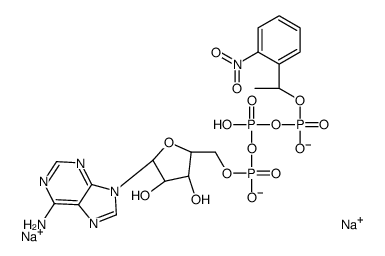CAGED ATP, DISODIUM SALT

CAGED ATP, DISODIUM SALT structure
|
Common Name | CAGED ATP, DISODIUM SALT | ||
|---|---|---|---|---|
| CAS Number | 171800-68-3 | Molecular Weight | 700.29100 | |
| Density | N/A | Boiling Point | N/A | |
| Molecular Formula | C18H21N6Na2O15P3 | Melting Point | N/A | |
| MSDS | Chinese USA | Flash Point | N/A | |
|
Levitational Image Cytometry with Temporal Resolution.
Adv. Mater. 27 , 3901-8, (2015) A simple, yet powerful magnetic-levitation-based device is reported for real-time, label-free separation, as well as high-resolution monitoring of cell populations based on their unique magnetic and density signatures. This method allows a wide variety of cel... |
|
|
Caged ATP as a tool in active transport research.
Soc. Gen. Physiol. Ser. 40 , 385, (1986)
|
|
|
Relaxation of muscle fibres by photolysis of caged ATP.
Nature 300 , 701, (1982) A novel method has been developed for studying the reaction kinetics of the force-generating mechanism in muscle. Inert photolabile precursors of ATP or ADP are incorporated into muscle fibres having their surface membrane barrier removed. The nucleotide is t... |
|
|
The reaction process of firefly bioluminescence triggered by photolysis of caged-ATP.
Photochem. Photobiol. 87 , 653-658, (2011) The reaction process of firefly bioluminescence was studied by photolyzing caged-ATP to adenosine triphosphate (ATP) within 100 ms. The intensity of luminescence increases markedly to reach a maximum within 1 s, maintains almost the same intensity up to 5 s a... |
|
|
Spectroscopic investigation of the reaction mechanism of CopB-B, the catalytic fragment from an archaeal thermophilic ATP-driven heavy metal transporter.
FEBS J. 276 , 6172-6186, (2009) The mechanism of ATP hydrolysis of a shortened variant of the heavy metal-translocating P-type ATPase CopB of Sulfolobus solfataricus was studied. The catalytic fragment, named CopB-B, comprises the nucleotide binding and phosphorylation domains. We demonstra... |
|
|
A new approach to time-resolved studies of ATP-requiring biological systems; laser flash photolysis of caged ATP.
Proc. Natl. Acad. Sci. U. S. A. 77 , 7237, (1980) 2-Nitrobenzyl derivatives have been used for several years as photolabile protecting groups in synthetic organic chemistry. Recently, P3-1-(2-nitro phenylethyladenosine 5'-triphosphate "caged ATP" was synthesized and its photolysis was shown to generate ATP i... |
|
|
Direct observation of the myosin Va recovery stroke that contributes to unidirectional stepping along actin.
PLoS Biol. 9 , e1001031, (2011) Myosins are ATP-driven linear molecular motors that work as cellular force generators, transporters, and force sensors. These functions are driven by large-scale nucleotide-dependent conformational changes, termed "strokes"; the "power stroke" is the force-ge... |
|
|
Direct observation of the myosin Va recovery stroke that contributes to unidirectional stepping along actin. Shiroguchi K, Chin HF, et al.
PLoS Biol. , e1001031, (2011)
|